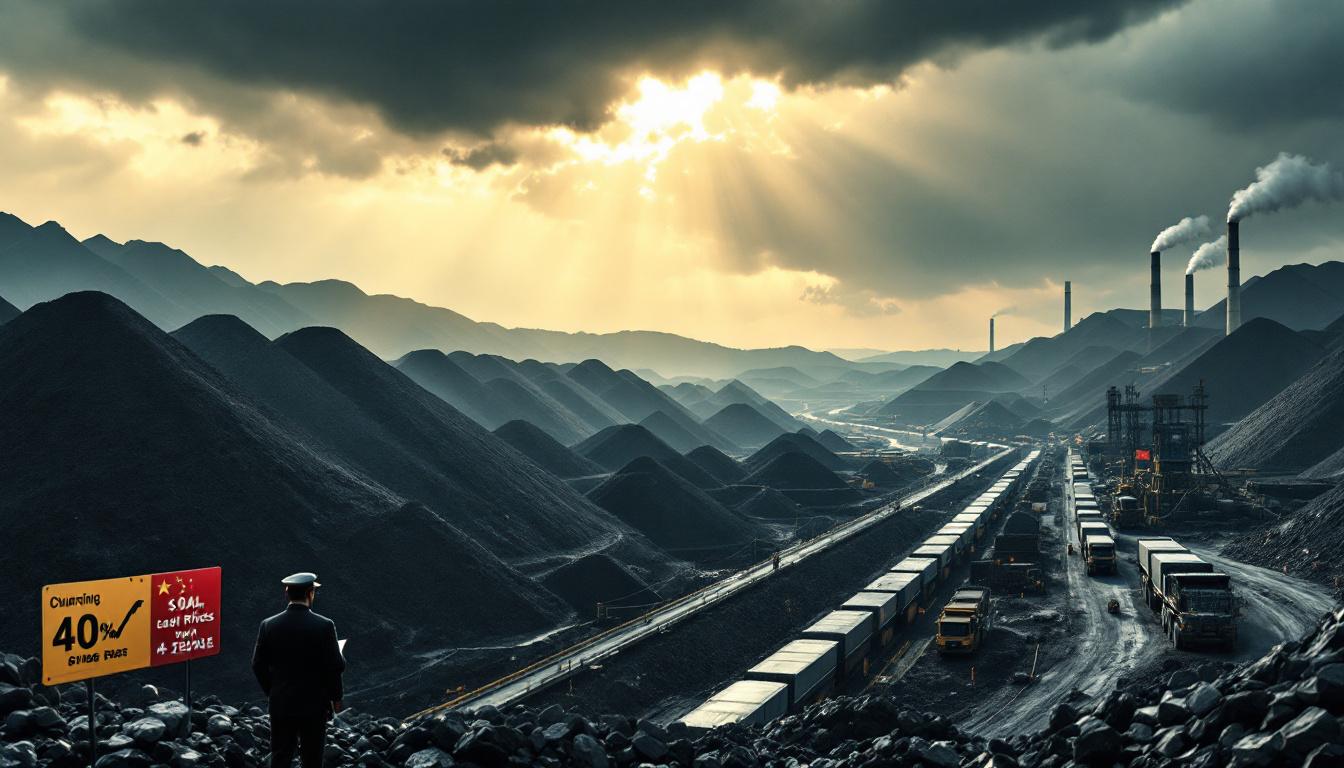China's Critical Mineral Dominance: A Global Power Play
China has established a commanding position in the processing capabilities for numerous critical minerals, creating significant dependencies in global supply chains. While raw materials may be geographically dispersed worldwide, China has effectively consolidated control over processing infrastructure for battery metals, rare earth elements, and vital industrial inputs.
"China really has locked up the processing capabilities for battery metals, rare earths used in defense," explains Rachel Siemba, Senior Adviser to Horizon Engaged. This strategic control extends far beyond economic advantage.
The weaponization of these supply chains has become increasingly evident. China has demonstrated willingness to implement China export controls and create artificial bottlenecks, using supply access as negotiating leverage in international relations—effectively turning mineral resources into tools of geopolitical influence.
The Current Security-Economic Balancing Act
Countries worldwide are increasingly viewing mineral supply chains through a national security lens. The United States, European Union, and allied nations have developed critical minerals energy security strategies, classifying certain resources as strategically vital to national interests.
Meanwhile, resource-rich nations are no longer content with merely extracting raw materials. As Siemba notes, these countries "don't want to just be a place where raw materials are extracted… they want to build processing and manufacturing" capacity domestically.
This push toward capturing more value has led to new government policies requiring technology transfer as part of mining agreements, alongside strategic partnerships aimed at building complete value chains within national borders.
Time Mismatches: Mining's Long Game vs. Political Short-Termism
The mining industry operates on fundamentally different timelines than political systems, creating significant challenges for supply chain regionalization efforts.
In North America and similar jurisdictions, the average mine development takes 7-10 years from discovery to production. Processing facilities require an additional 3-5 years for planning, permitting, and construction. Meanwhile, political cycles typically operate on 2-4 year timeframes.
"Decisions to build a mine take years, not months… [with] decades in some countries for approval," notes Siemba. This fundamental mismatch creates policy inconsistency and complicates long-term investment decisions.
Market Volatility Compounds Timeline Challenges
Current market dynamics further complicate regionalization efforts. Temporary oversupply in certain minerals like lithium creates price volatility and investor hesitancy, despite strong long-term demand forecasts.
This volatility makes capital attraction particularly challenging during market downturns, creating difficulty in maintaining momentum for supply chain development during price troughs—even when strategic imperatives remain unchanged.
Trade Policies: New Barriers in Mineral Markets
The mining sector is increasingly caught in broader trade tensions, transforming what was historically a relatively open market.
"Creative trade tools are being used… leading to distortions," explains Siemba. Mining and processed commodities were historically exempt from extensive tariffs, but now "they are part of trade taxes," creating new complexities for supply chain development.
The Challenge of Government Deal Opacity
The competitive landscape for critical mineral investment is increasingly complex and often opaque. Government incentives and deals frequently "lack transparency," making it "harder to know incentives" driving investment decisions.
This opacity creates challenges in distinguishing commercial from strategic motivations and assessing the true economics of competing projects due to hidden subsidies and strategic partnerships between governments and companies.
Regional Leaders in Supply Chain Transformation
Several regions are emerging as leaders in the push toward regionalized mineral supply chains, each with distinct strategies and advantages.
Middle East's Strategic Pivot
Gulf states are leveraging their financial resources to secure positions throughout mineral value chains. The United Arab Emirates has adopted an outward-looking strategy, making "active investments in African mining… expanding to processing" and forming partnerships with Western nations.
Saudi Arabia, in contrast, emphasizes "domestic job creation" through entities like Ma'aden, focusing on internal capacity building and using foreign partnerships primarily for technology transfer to support economic diversification.
Africa's Value Addition Aspirations
African nations are strategically positioning themselves between competing global powers to maximize economic benefits. The Democratic Republic of Congo is "courted by U.S./China" for critical mineral access, while infrastructure projects like the Lobito Corridor are creating new pathways for mineral flows.
These countries are increasingly implementing requirements for in-country processing and value addition, moving beyond their traditional role as raw material suppliers.
Recycling's Growing Role in Mineral Security
Recycling is becoming an increasingly important component of mineral supply strategies, though capabilities remain geographically concentrated.
"China dominates recycling… Nigeria [is] a hub for base metal recycling," notes Siemba. Middle Eastern countries are also "exploring recycling as part of mineral strategies" to complement their broader resource development plans.
The Knowledge Gap Challenge
Technology transfer remains a significant barrier to expanding recycling capacity. Specialized expertise is required to develop efficient recycling processes, creating both challenges and opportunities for technology partnerships between developed and developing nations.
As investment in research and development increases, battery recycling breakthrough technologies could become a competitive advantage in regionalized supply chains, potentially reducing dependency on primary extraction over time.
Middle Eastern Investors: Transforming the Mining Landscape
Middle Eastern investment in mining represents a strategic pivot beyond traditional energy sectors, using petroleum wealth to secure positions in future-oriented mineral resources.
UAE's Global Mining Portfolio
The Emirates has adopted an outward-looking investment strategy, "moving into processing opportunities, not just mining" across multiple jurisdictions. Their approach balances portfolio diversification with strategic resource access, with generally less concern about Chinese competition than their Western counterparts.
The UAE's Oklahoma critical minerals project exemplifies this strategy, demonstrating their willingness to partner with Western nations while maintaining a globally diversified approach.
Saudi Arabia's Domestic Value Chains
The Kingdom's approach centers on internal capacity building, using partnerships for "technology transfer" to develop domestic industries. Their strategy integrates mining into broader economic diversification plans, with particular emphasis on building complete value chains from extraction to manufacturing—including ambitious electric vehicle supply chain development.
New Financial Structures for Mining Investment
Traditional mining finance is being supplemented by innovative approaches that better align with the sector's unique challenges and strategic importance.
The G7 action plan aims to develop "standard-based financial markets for critical minerals," potentially creating new frameworks for mineral investment. Joint investment structures between government and private entities are emerging, along with potential new hedging and trading mechanisms to improve market liquidity.
Middle East's Advantage: Patient Capital
Gulf investors may offer distinct advantages in the mining sector due to their "longer planning cycles" that better suit mining's extended timelines. Their ability to maintain consistent investment strategies over longer timeframes aligns well with mining development needs, with strategic rather than purely financial investment motivations guiding decisions.
Technology's Role in Reshaping Mineral Supply Chains
Technology is enabling more efficient resource development, with advanced analytics allowing companies to "reassess geological data" and improve extraction techniques at existing operations.
The AI-Mineral Connection
The growth of artificial intelligence is creating new mineral demand drivers through increased energy storage requirements. AI in mining innovation is creating a feedback loop between technology advancement and mineral consumption, as AI-driven data centers "demand critical minerals for battery facilities."
This connection creates opportunities for integrated energy and mineral strategies, though technology efficiency improvements may eventually moderate demand growth.
Future Trends: New Partnerships and Economic Realities
New collaborative approaches are likely to shape future development of regionalized mineral supply chains, with "Quad partnerships" between the US, Japan, India, and Australia developing initiatives on critical minerals.
Strategic minerals reserve programs may address short-term supply disruptions, while public-private partnerships spanning multiple jurisdictions create new models for development. As noted in the OECD's analysis of regional mining ecosystems, these collaborative structures are becoming increasingly important for supply chain resilience.
The Economics of Regionalization
The economics of regionalized supply chains remain challenging, with higher costs of production outside established Chinese supply chains requiring government support during the development phase.
Balancing commercial viability with strategic security considerations will be crucial, as long-term sustainability ultimately requires economic competitiveness—even for strategically vital resources. According to recent research on supply chain resilience, this balance between cost efficiency and security will define successful regionalization efforts.
U.S. Policy as a Key Variable
American policy choices will significantly influence global development patterns. Implementation details of incentive programs like the Inflation Reduction Act, potential sectoral tariffs, and foreign investment screening mechanisms will shape investment flows and partnership possibilities across the mineral sector.
Critical Questions About Mining Supply Chain Regionalization
What is driving the push for regionalized mining supply chains?
The primary drivers include national security concerns about resource dependencies, economic development aspirations of resource-rich nations, and strategic positioning for the energy transition. China's dominant position in processing infrastructure has created vulnerabilities that many countries are now working to address through development of alternative supply chains.
How long does it take to develop new mining supply chains?
Developing complete supply chains requires significant time investment. New mines typically take 7-10 years from discovery to production in developed jurisdictions, while processing facilities require 3-5 years for planning and construction. This timeline mismatch with political cycles (typically 2-4 years) creates challenges for consistent policy implementation.
Which countries are most actively investing in mining supply chain development?
The United Arab Emirates and Saudi Arabia are emerging as significant investors, though with different approaches. The UAE focuses on international investments, particularly in Africa, while Saudi Arabia emphasizes domestic resource development. Traditional mining nations like Australia, Canada, and the US are also accelerating investment, while African nations are implementing policies to capture more value from their resources.
What role will recycling play in future mineral supply?
Recycling is expected to become increasingly important as a complementary source of critical minerals. Currently, China dominates recycling infrastructure for many materials, but new hubs are emerging in Africa and elsewhere. As technology improves and more end-of-life products become available, recycling could significantly reduce dependency on primary extraction.
Future-Proofing Mining Supply Chains
Balancing Security with Economics
Successful regionalization strategies must eventually achieve economic sustainability. Initial government support may be necessary to overcome established advantages, but scale economies will require coordination across allied nations.
Investment in technology to reduce production costs in higher-wage jurisdictions will be essential, alongside standardization to enable more efficient market development.
Building Resilient Rather Than Isolated Supply Chains
The goal should be resilience rather than complete self-sufficiency. Diversified supply sources rather than domestic-only approaches, combined with strategic partnerships among like-minded nations, can create redundancy in critical supply chain components while maintaining flexibility to adapt to changing technology requirements.
Addressing Skills and Knowledge Gaps
Human capital development is essential for successful regionalization. Investment in technical education and workforce development, knowledge transfer programs between established and emerging mining jurisdictions, and research to improve processing efficiency will all play vital roles in building the expertise needed for sustainable supply chains.
Building regulatory expertise to enable efficient permitting and oversight remains a critical challenge, particularly in jurisdictions without established mining traditions but with significant mineral potential.
Want to Stay Ahead of Critical Mineral Market Shifts?
Discover investment opportunities in the rapidly evolving minerals sector before they hit mainstream markets. Visit Discovery Alert's discoveries page to see how their proprietary Discovery IQ model identifies significant ASX mineral announcements in real-time, giving you the crucial market edge in critical minerals investing.




